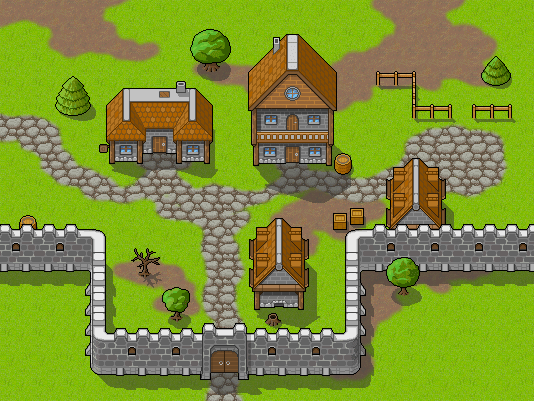This video tutorial is the re-release of the course created by the same author a couple of years ago, on How to make TOP DOWN RPG game with Unity.
The course although having some years old, is still very relevant from a point of view of the lessons explained, and will guide you on How to make TOP DOWN RPG game with Unity.
What is an RPG
A role-playing game (RPG) is a video game genre in which the player controls a fictitious character (or characters) on a mission in a fictional universe.
Due to the wide variety of hybrid genres that have RPG features, defining RPGs is difficult.
Traditional role-playing video games have five common features:
The ability to improve your character by improving his statistics or levels during the course of the game.
A menu-based combat system featuring many skill, spell, and active power options, as well as an active inventory system with wearable armor and weaponry.
A main quest with a storyline that runs throughout the game, as well as supplemental (and usually optional) side tasks.
Additional abilities allow you to interact with elements of the environment or storyline (e.g. lockpicking, disarming traps, communication skills, etc.)
The existence of character classes that define a character’s personality, skills, abilities, and spells (e.g. wizard, thief, warrior, etc.)
Modern and hybrid RPGs don’t have to include all of these characteristics, but they frequently do, with one or two mixed in with elements from another genre.
What is the Origin of RPG Games
RPG video games, originating from tabletop and paper RPGs such as Rolemaster and Dungeons & Dragons (D&D), are a type of game in which players assume the role of their own characters and actively describe their actions and thoughts.
In video game RPGs, the part of the ‘game master’ that acts as narrator and referee is automated, and the computer’s artificial intelligence (AI) determines the actions of various non-player characters (NPCs) and enemies.
In old-fashioned RPGs, a central plot was essential, but in more modern games, such as Massively Multiplayer Online RPGs (MMORPGs), it is no longer a requirement.
Most RPGs are set in fictional worlds with traditional fantasy or science fiction elements that are incorporated into the game mechanics. For example, the choice of race, such as dwarves or elves, can influence the choice of characters in the game and alter their characteristics and ability to cast spells.
In the classic tabletop RPG, a set of explicit rules defined how a character could interact with the environment. Typically, characters had to roll a die to determine whether an attempted action (punching an enemy, climbing a wall, etc.) was successful or not.
Video game RPGs started out as pen-and-paper games, but instead of dice, the dice were rolled automatically across the screen. Combat is handled by interactive menus and can be turn-based or real-time.
In modern gaming, however, several hybrids have emerged, greatly expanding the range of the genre.
JRPGs combine story telling with statistics, western RPGs combine statistics with free roaming, and sRPGs combine the jRPG system with the minis that are occasionally used in tabletop RPGs. It goes on and on.
In almost all RPGs, you can statistically advance your character by “leveling up,” although this isn’t always the case. Characters also progress by obtaining new skills and leveling up during the game. In most RPGs, there is a magic system or a system that stands in for it. Many games that perform these things aren’t categorized as RPGs, but they do include RPG features (e.g. The Legend of Zelda series).
Types of RPG Games
The most important subcategories of the RPG genre are as follows
- Action RPG, Many of these games focus on combat rather than storytelling. Combat usually occurs in real time and the player often controls a single character rather than a party. Examples include. Diablo, Zelda, and the Dark Souls series.
- Strategy RPG, Games in which character units are placed on a map and played against each other. Character and party development is more important than the choice of battles, since an underdeveloped party can be overwhelmed by powerful, high-level enemies. For example, there are. Neverwinter and Final Fantasy franchises, which have important sub-genres such as Rogue RPGs and Tactical RPGs (e.g. X-COM, Jagged Alliance).
- Adventure RPG:Games: that focus on story rather than action. The player progresses through the story by collecting certain items and special weapons, meeting important NPCs, and completing important quests.
- Adventure RPGs: also typically fall into other categories. For example, the Fable franchise (which is also an action RPG) and the Divinity series are classified in the adventure RPG niche (Divine Divinity, Beyond Divinity) or the strategy RPG (Divinity: Original Sin). In addition, Metroidvania RPGs (such as Metroid and Castlevania II: Simon Quest) are often adventure RPGs with platforming elements.
- MMORPG: Massively Multiplayer Games are endless RPGs in which a large number of real-life players share a world and interact with each other, so to speak. MMORPGs are a mixture of various elements from other subgenres, but are generally combat-oriented, with a strong emphasis on collecting rare and powerful items to improve character abilities and appearance. Famous titles include World of Warcraft (WoW), Ultima Online and Guild Wars.
The popularity of the concept of “becoming someone else somewhere” means that we can expect to see many more variations in the future.
How to make TOP DOWN RPG game with Unity game with Unity Video’s TimeStamps
0:00:00 – Intro
0:01:31 – Setting up
0:16:03 – Moving and Manual Collision Detection
1:03:06 – Tilemap and Designing Dungeon
1:40:31 – Interactive Objects and Inheritance
2:15:37 – Saving Game’s State
2:41:31 – Floating Text System
3:11:11 – Top Down Combat System
4:13:32 – Animator and Weapon Swing Animation
4:35:27 – Character Menu and the new UI System
6:00:00 – Polishing and Adding Content
For more interesting tutorials, don´t hesitate to take a look at our main webpage.
